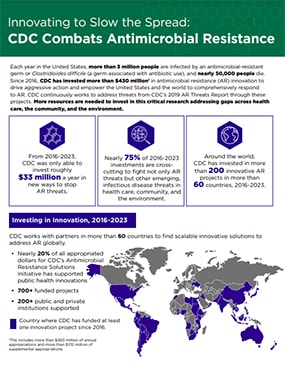Innovative Actions to Fight Antimicrobial Resistance
CDC invests in innovative research projects to identify and implement new ways to combat antimicrobial resistance globally. Data from these projects help CDC better protect people by, for example, uncovering places resistant germs live and spread, improving outbreak response, and strengthening infection prevention practices.
CDC also has one of the largest collections of antimicrobial-resistant isolates (pure samples of a germ) and provides these isolates to approved institutions through the CDC and FDA AR Isolate Bank. The curated collections of resistant organisms help microbiologists, drug and diagnostic manufacturers, and researchers improve patient care.
CDC’s investments in innovation to combat AR since 2016 include:
- Funded more than 700 innovation projects
- Collaborated with more than 200 public and private institutions
- Invested more than $430 million to address knowledge gaps with scalable solutions
- Awarded more than $57 million through the Broad Agency Announcement (a specific funding mechanism)
- Filled more than 8,000 isolate panel orders through the AR Isolate Bank, totaling almost 325,000 isolates
CDC implements activities outlined in the U.S. National Action Plan for Combating Antibiotic-Resistant Bacteria, released in 2015 and 2020. These activities are funded through CDC antimicrobial resistance investments, collectively known as CDC’s Antimicrobial Resistance (AR) Solutions Initiative. Through these investments, CDC is transforming how the nation combats antimicrobial resistance.
CDC Activities
Building Insights for Healthcare Practice
- Working with partners to discover, implement, and evaluate innovative strategies to improve healthcare quality, infection prevention, and patient safety
- Assessing how antibiotic and antifungal use programs can be optimized to improve patient safety
- Enhancing infection control to prevent spread of germs, including evaluating cleaning methods and measuring the impact of setting-specific strategies (like strategies developed specifically for nursing homes)
- Gathering more infection data from healthcare facilities to better measure the challenges influencing healthcare quality and patient safety and implement solutions
Providing Information for Research and Development
- Using the AR Isolate Bank to provide antimicrobial resistance information and support innovation in diagnostics and drug development
Conducting Applied Research on the Microbiome
- Identifying and sharing effective public health approaches to protect people’s microbiomes (a community of naturally occurring germs in and on our bodies), for example CDC and NIH co-edited a supplement issue in the Journal of Infectious Diseases (JID) titled The State of Microbiome Science at the Intersection of Infectious Diseases and Antimicrobial Resistance
- Studying the connection between antibiotic use and microbiomes, including new ways to protect and restore the microbiome
- Determining how exposure to antibiotics early in life affects microbiome development
- Developing a predictive index that identifies a patient’s risk of microbiome disruption from a specific antibiotic, a patient’s likelihood of becoming a carrier of antimicrobial-resistant germs, and their risk of becoming infected with these germs
- Developing microbiome measurements to monitor a patient’s risk for carrying and spreading antimicrobial-resistant germs
- Improving strategies to tailor antibiotic use to a patient’s individual microbiome and to a specific population of patients (like a nursing home or doctor’s office)
Understanding Antimicrobial Resistance in the Environment (water, soil) and Risk to Human Health
- Investigating knowledge gaps around antimicrobial resistance in the environment
- Detecting and determining the amount of antimicrobial resistance elements (mechanisms like a gene that can share resistance) in discharged wastewater and soil, and the effectiveness of wastewater treatment systems
- Identifying antibiotic drug and resistance elements near healthcare and agriculture settings
- Investigating the role of premise wastewater plumbing, such as sink basins and faucets, in healthcare facilities in the spread of antimicrobial-resistant germs into patient-care areas
Examples of CDC Activities in Action
- Researchers from Duke University and University of North Carolina found UV light emitters as effective tools for intensely disinfecting rooms
- Ohio State University researchers evaluated antibiotic use decision-making tools and training for dairy calf producers, finding improved antibiotic use on these farms
- University of Georgia researchers studied azole-resistant Aspergillus fumigatus collected from select agricultural sites, helping CDC better understand the role of fungicide use on antifungal-resistance in the environment and how that might affect resistance in humans
- University of Oxford researchers are improving laboratory methods to detect drug-resistant gonorrhea directly from patient samples and create publicly available tools to analyze genetic data to better detect and treat the disease, potentially informing future standards or guidelines
- Researchers from the Instituto de Biomedicina y Biotecnología de Cantabria in Spain are identifying and evaluating the different structures and dynamics of Salmonella plasmids and how they spread resistance
- Studies between CDC and University of Virginia described the dispersal of bacteria from contaminated sink drain P-traps to the sink basin and surrounding areas when faucets are used, which helps researchers understand the way bacteria in sink drains spread in healthcare facilities
